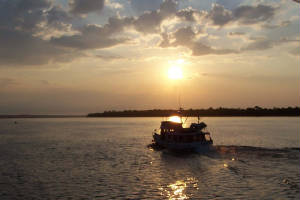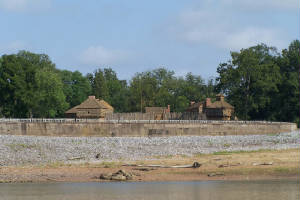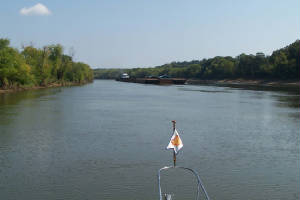September 20, 2005 Ohio River Lock 53 to Barkley Lake
72.4 miles
Our day began early as we woke to a storm on its way at 2 a.m. The wind was roaring, and kicking up
waves to rock our boat. After so many dry days in this summer of drought, we had to wonder about our luck in hitting
a big storm on the night we were in the most unprotected anchorage of our trip.
Dick got up and turned on the chart plotter, in case we dragged anchor and had to turn on the engines to
hold position. He stuck his arm out the door with the wind gauge, and got a reading of 35 mph. It surely would
have been higher if he had ventured out into an open spot to get a reading, but the weather and the hour did not invite further
investigation.
Dick stood watch through the storm, and invited me to just go back to bed and get some rest, which was difficult
with all the racket of the thunder and rain, the flashing of lightning and the more than gentle rocking of the boat.
As I lay awake in our cabin below, I could ocaisionally hear Dick's gentle snoring interspersed with the sounds of the storm,
so I knew he was leading by example, and I really should get some sleep.

|
| Ohio River sunrise |
The storm calmed a bit around 4 a.m., and we got a bit of sleep before our alarm went off at 6 a.m.
We wanted to get an early start, because today we had two locks with potentially long waits for commercial traffic on the
Ohio River, and we had over seventy miles to travel upstream.
We called the lock tender as soon as we got up to check on the barge traffic, and get an estimate on
when we could get through. He said he was clear right then, and asked how long it would take us to get there.
Dick told him twenty minutes, and we went into high gear, throwing on our clothes, setting up our navigation instruments,
and hoisting anchor in the dark. We rose in the lock as the sun cleared the horizon.
The lock actually has two chambers -- a very large one that can handle big and wide barge loads, and a smaller
chamber for tows with just a few barges or smaller size craft like us. As we were going through, we could smell the
barges in the big chamber next to us -- their load smelled like toast. The barges waiting to go through upstream
smelled like malt.
Listening to the working channel, we learned that the big lock takes twelve loads downstream, then
takes twelve upstream. Although at first it would seem more efficient to alternate, taking one tow down, then taking
another up, with the size of these tows, it is faster to let all the tows stage one behind another going in one direction.
That way, they don't have to get out of each other's way as tows coming out from one direction meet tows waiting to come in
from another.
When we went through, the northbound queue was thirteen tows. When the captain of the tow who
was thirteenth called in to the lock for instruction, the lockmaster told him he was just starting the first of his northbound
loads, and would have to get twelve northbound loads and twelve southbound loads through before that tow's turn came up.
The lockmaster advised him to find a spot along the bank to park his load, because his wait would be at least twenty hours.
We then heard the towboat captain call the captain of the tow in front of him in line for advice on where to wait, since he
hadn't been on this part of the river for twenty years, and needed local knowledge.
The Ohio River is perilously low for tows. Many have gone aground around Cairo, we heard. We listened
to an Army Corps of Engineers working boat communicating with the tow captains, as the Corps boat set about moving buoys
to narrow the channel and help them navigate around the shallow and shoaled areas. One towboat captain we heard said
that his company had prohibited tows from going north of Lock 53 until the water levels rise. Another said his company
took some of the deepest draft barges from his tow, and he went on. Yet another said his barges only draw 9' (the controlling
depth of the channel), but his towboat draws 10' 2". He wasn't worried -- if his tow went aground he could always power
his way out of the mud.
One interesting conversation we heard was between a tow captain who had just come up from around New
Orleans (let's call him Captain A), and another captain (B) whose brother's tow was sent to New Orleans before Katrina
hit. Captain B had not heard from his brother, and asked Captain A if he had seen his boat. Captain A said he
thought the brother's boat had been washed up on a bank, but they got it off, and it left New Orleans. Captain B said,
maybe Katrina will make them think twice before sending tows into a hurricane again, and Captain A just laughed, and said
he didn't think it would make a bit of difference.

|
| Fort Massac |
Listening to the working channel on the VHF radio, you know that the men who work the river have a
million stories. Then, there are all the stories of the towns tucked behind their flood walls, the farms, the quarries and
grain elevators, the houses high on the bluffs, and the shanties on the flood plain.
We passed Fort Massac on the Illinois bank of the river mid-morning. The French built the fort in
1757 to defend against the British, but ended up ceding the fort to Britain in 1763 after the French and Indian War.
George Rogers Clark and his 175 "Long Knives" claimed it for the United States in 1778, as part of their mission to clear
the British from the new country's western frontier. Meriwether Lewis and William Clark (George Rogers Clark's younger
brother) stopped at Fort Massac to reprovision and add crew on their historic expedition of discovery.
Around midday, we passed Paducah, a city that thrives on river commerce. Paducah has been a barge-building
and repair center for over 100 years. All commercial traffic coming upriver from the Ohio, Tennessee and Cumberland
Rivers passes by Paducah. It is the northernmost ice-free city on the river system. It is also home to the Center for
Maritime Education, where fourteen of the largest barge companies send their crews for professional training. The Center
has four interactive pilothouse simulators and other state-of-the-art training facilities.
Before this trip, we were oblivious to Paducah's importance in the world of tows and barges. We knew
and loved it as a quilter's Mecca, and site of the American Quilting Society Museum. It also has artistically meritorious
historic murals painted all along its floodwalls, facing the city. From the water, the walls are stark concrete.

|
| Cumberland River |
We reached the Cumberland River six hours into our cruising day. The Cumberland is a narrower river
with more twists and turns than the Ohio, but it still carries a lot of barge traffic. A couple mile section just beyond
the Ohio serves as a barge staging area, and both banks are lined with barges. Further along, we passed a massive quarrying
operation, where a conveyor was loading gravel onto barges and tows were assembling their loads.
We met tows pushing barges around curves in the river several times. One of the loads was five
barges long and three wide, which seemed like a very big load for such a small river.
Ten hours into this very long cruising day, we arrived at Barkley Lock, one of the highest elevation change
locks of our trip. We cruised right into the lock with no waiting, were lifted up 57 feet in just ten minutes, and were
out into Barkley Lake in what seemed like no time at all.
Our day's end destination, Green Turtle Bay Marina, was just fifteen minutes away. We were all tied
up at our slip by 6 p.m., but we still had work to do. While many Looper friends we had met along the way sat in a lovely
pagoda on the bluff above us enjoying cocktail hour, we worked to pack up and secure our boat so we could leave it for a week.
We were heading home to Cincinnati for a week, starting tomorrow, and we would not be deterred from our labors. All
this cruising may have relaxed us a little, but at our core, we are still Type As.
Where are we now? We are back home working in our garden, spending time with family and
friends, and visiting our dentist, doctor and hair dresser.
The house feels really big, and the car feels really small. Traffic seems way too fast and way
too close. It feels good to have our hands in the dirt. It is a pleasure to walk in the grocery store and
know where everything is located. I just wore high heels for the first time in over a year today, and it was a wobbly
experience.
The grandchildren have all changed, some more than others, since last we last saw them. They have
developed new talents and skills since we were home last spring, and it was a joy to see them and catch up on their interests
and activities.
It is nice to be home, but we are looking forward to getting back afloat. A week is long enough aground.
Click here to continue to Page 2.
|

